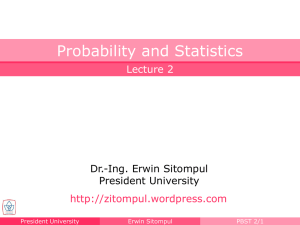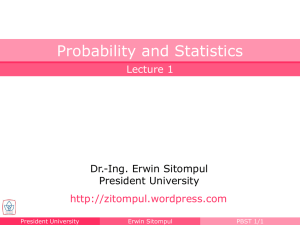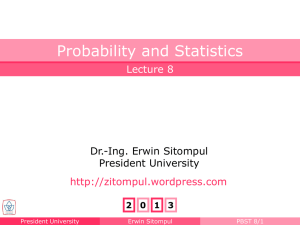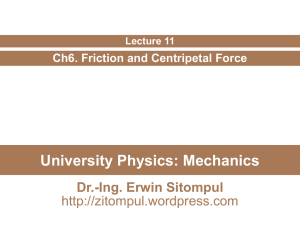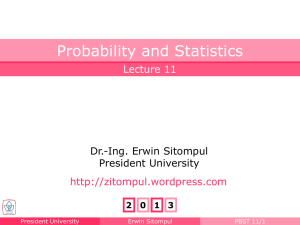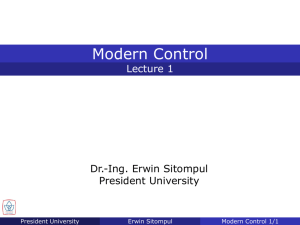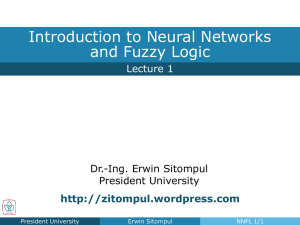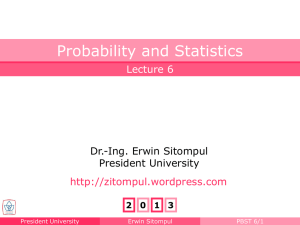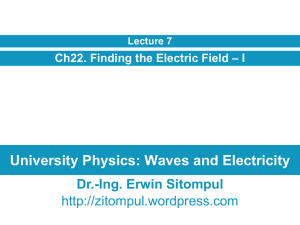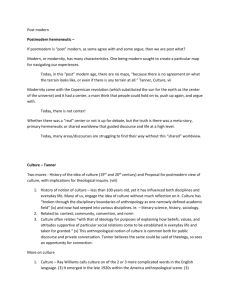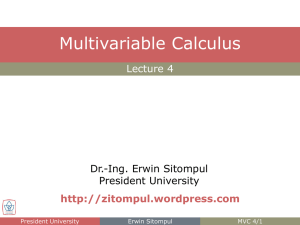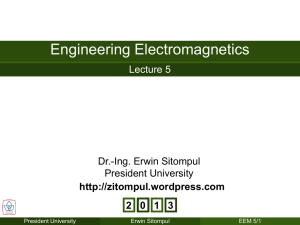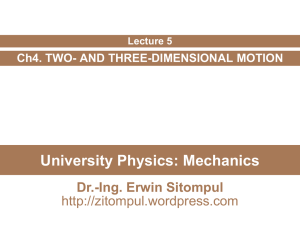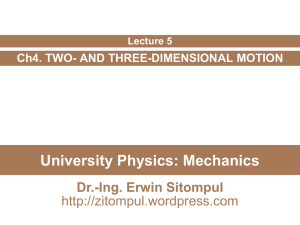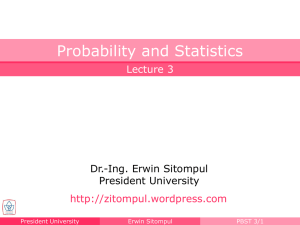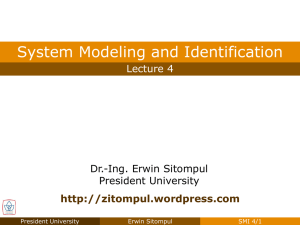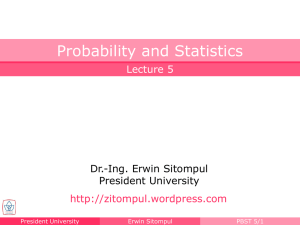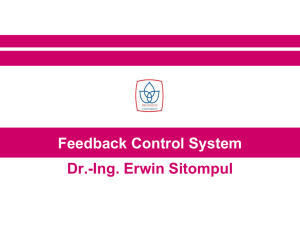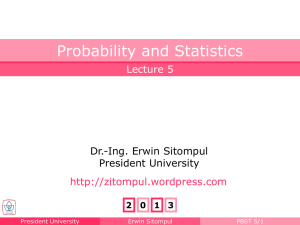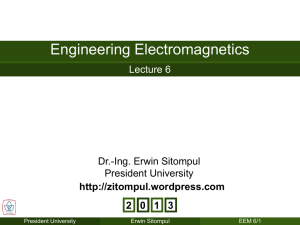X - Erwin Sitompul
advertisement
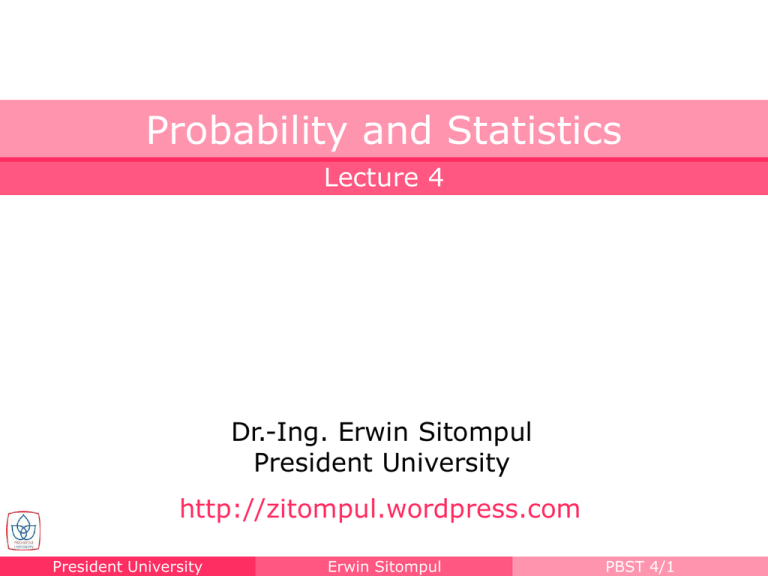
Probability and Statistics
Lecture 4
Dr.-Ing. Erwin Sitompul
President University
http://zitompul.wordpress.com
President University
Erwin Sitompul
PBST 4/1
Chapter 4
Mathematical Expectation
Chapter 4
Mathematical Expectation
President University
Erwin Sitompul
PBST 4/2
Chapter 4.1
Mean of a Random Variable
Mean of a Random Variable
If two coins are tossed 16 times and X is the number of heads that
occur per toss, then the values of X can be 0, 1, and 2.
Suppose that the experiment yields no heads, one head, and two
heads a total of 4, 7, and 5 times, respectively.
The average number of heads per toss of the two coins is then
(0)(4) (1)(7 ) (2)(5)
1.06
16
The value means that on average we can expect that by each toss
the head will occur for 1.06 times and no head for 0.94 times.
1.06 is called an expected value, a tem used to describe the longterm average outcome of a given scenario.
President University
Erwin Sitompul
PBST 4/3
Chapter 4.1
Mean of a Random Variable
Mean of a Random Variable
Let X be a random variable with probability distribution f(x). The
mean or expected value of X is
E(X )
xf ( x )
x
if X is discrete, and
E(X )
xf ( x ) dx
if X is continuous.
President University
Erwin Sitompul
PBST 4/4
Chapter 4.1
Mean of a Random Variable
Mean of a Random Variable
A lot containing 7 components is sampled by a quality inspector, the
lot contains 4 good components and 3 defective components. A
sample of 3 is taken by the inspector. Find the expected value of the
number of good components in this sample
Let X represent the number of good components in the sample. The
probability distribution of X is
f ( x)
4
C x 3 C 3 x
7
f (0)
1
C3
, f (1)
35
E(X )
, fo r x 0,1, 2, 3
12
35
x
, f (2)
18
35
,
f (3)
4
35
12
1
12
18
4
(1)
(2)
(3)
1.714
xf ( x ) (0)
35
35
35
35
7
Thus, if 3 components are selected at random over and over again
from a lot of 4 good components and 3 defective components, one
will pick on average 1.7 good components and, accordingly, 1.3 bad
components.
President University
Erwin Sitompul
PBST 4/5
Chapter 4.1
Mean of a Random Variable
Mean of a Random Variable
In a gambling game a man is paid $5 if he gets all heads or all tails
when three coins are tossed, and he will pay out $3 if either one or
two heads show. What is his expected gain?
The sample space for the possible outcomes of this game is
S {H H H , H H T , H TH ,TH H , H TT ,TH T ,TTH ,TTT }
Each of these events is equally likely and occurs with probability of
each equal to 1/8.
Let Y be the amount of money the
gambler can win, E1 is the event of
winning 5$ and E2 is event of losing $3,
y
5
3
f ( y ) P [Y y ]
1 4
3 4
E1 { HHH , TTT }
E 2 { HHT , HTH , THH , HTT , THT , TTH }
1
3
E (Y ) yf ( y ) (5) ( 3) 1
4
4
y
In this game the gambler will, on average, loss $1 per toss of the
three coins.
President University
Erwin Sitompul
PBST 4/6
Chapter 4.1
Mean of a Random Variable
Mean of a Random Variable
A salesperson has two appointments on a given day. He believes that
he has 70% chance to make the deal at the first appointment, from
which he can earn $1000 commission if successful. On the other
hand, he thinks he only has a 40% chance to make the deal at the
second appointment, which will give him $1500 if successful.
What is his expected commission based on his own probability
belief? Assume that the appointment results are independent of each
other.
Let X be the commission the salesperson will earn. Due to
independence, the probabilities can be calculated as
f ($0) (1 0.7 )(1 0.4) 0.18
f ($1000) (0.7 )(1 0.4) 0.42
f ($1500) (1 0.7 )(0.4) 0.12
f ($2500) (0.7 )(0.4) 0.28
E(X )
xf ( x )
x
($0)(0.18) ($1000)(0.42) ($1500)(0.12) ($25 00)(0.28) $1300
President University
Erwin Sitompul
PBST 4/7
Chapter 4.1
Mean of a Random Variable
Mean of a Random Variable
Let X be the random variable that denotes the life in hours of a
certain electronic device. The probability density function is
2 0, 0 0 0
,
f (x) x3
0,
x 100
e ls e w h e re
Find the expected life of this type of device.
E(X )
20, 000
x
xf ( x ) dx
x 3 dx
100
100
20, 000
x
2
dx
20, 000
x
200
100
Therefore, we can expect this type of device to function well for, on
average, 200 hours.
President University
Erwin Sitompul
PBST 4/8
Chapter 4.1
Mean of a Random Variable
Mean of a Random Variable
Let X be a random variable with probability distribution f(x). The
mean or expected value of the random variable g(X) is
g ( X ) E g ( X )
g (x) f (x)
if X is discrete, and
g ( X ) E g ( X )
if X is continuous.
President University
g ( x ) f ( x ) dx
Erwin Sitompul
PBST 4/9
Chapter 4.1
Mean of a Random Variable
Mean of a Random Variable
Suppose that the number of cars X that pass through a car wash
between 4:00 P.M. and 5:00 P.M. on any sunny Friday has the
following probability distribution:
Let g(X) = 2X – 1 represent the amount of money in dollars, paid to
the attendant by the manager. Find the attendant’s expected
earnings for this particular time period.
E g ( X ) E 2 X 1
9
(2 x 1) f ( x )
x4
1
1
1
1
($7 )
($9)
($11)
($13)
12
12
4
4
1
1
($15) ($17 )
6
6
$12.67
President University
Erwin Sitompul
PBST 4/10
Chapter 4.1
Mean of a Random Variable
Mean of a Random Variable
Let X be a random variable with density function
x2
,
f ( x) 3
0,
1 x 2
e lse w h e re
Find the expected value of g(X) = 4X + 3.
E g ( X )
x2
x4 x3
g ( x ) f ( x ) dx (4 x 3)
dx
3
3
1
President University
2
Erwin Sitompul
2
8
1
PBST 4/11
Chapter 4.1
Mean of a Random Variable
Mean of a Random Variable
Let X and Y be random variables with joint probability distribution
f(x,y). The mean or expected value of the random variable g(X,Y)
is
g ( X ,Y ) E g ( X , Y )
g ( x, y ) f ( x, y )
x
y
if X and Y are discrete, and
g ( X ,Y ) E g ( X , Y )
g ( x , y ) f ( x , y ) dxdy
if X and Y are continuous.
President University
Erwin Sitompul
PBST 4/12
Chapter 4.1
Mean of a Random Variable
Mean of a Random Variable
Let X and Y be a random variables
with joint probability density function
as in the “ballpoint pens” example.
Find the expected value of g(X,Y) = XY
E XY
2
2
xyf ( x , y )
x0 y0
3
3
1
9
3
(0)(0)
(0)(1)
(0)(2)
(1)(0)
(1)(1)
28
14
28
28
14
3
(1)(2)(0) (2)(0)
(2)(1)(0) (2)(2)(0)
28
3
14
President University
Erwin Sitompul
PBST 4/13
Chapter 4.1
Mean of a Random Variable
Mean of a Random Variable
Find E(Y/X) for the density function
x (1 3 y 2 )
,
f ( x, y )
4
0,
Y
E
X
e lse w h e re
2
y x (1 3 y )
dxdy
x
4
0 0
1 2
1 2
0 x 2, 0 y 1
0 0
y 3y
3
dxdy
4
1
3y
2 y
x0
8
16
0
5
8
2
President University
4
Erwin Sitompul
PBST 4/14
Probability and Statistics
Homework 4
1. From a regular deck of 52 playing cards we pick one at random. Let the
random variable X equal the number on the card if it is a numbered one
(ace counts as 1) and 10 if it is a face card (J, Q, and K). Find E(X).
1
2
3
4
5
6
7
8
9
10
10
10
10
2. Four indistinguishable balls are distributed randomly into 3
distinguishable boxes. Let X denote the number of balls that end up in
the first box. Find E(X).
(Sch.E5.1.1-2)
President University
Erwin Sitompul
PBST 4/15
